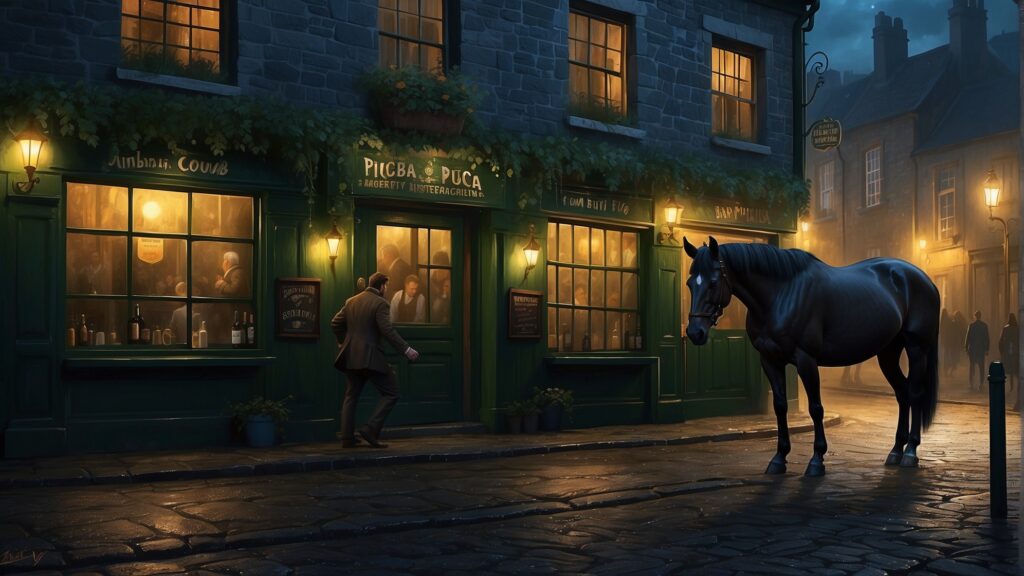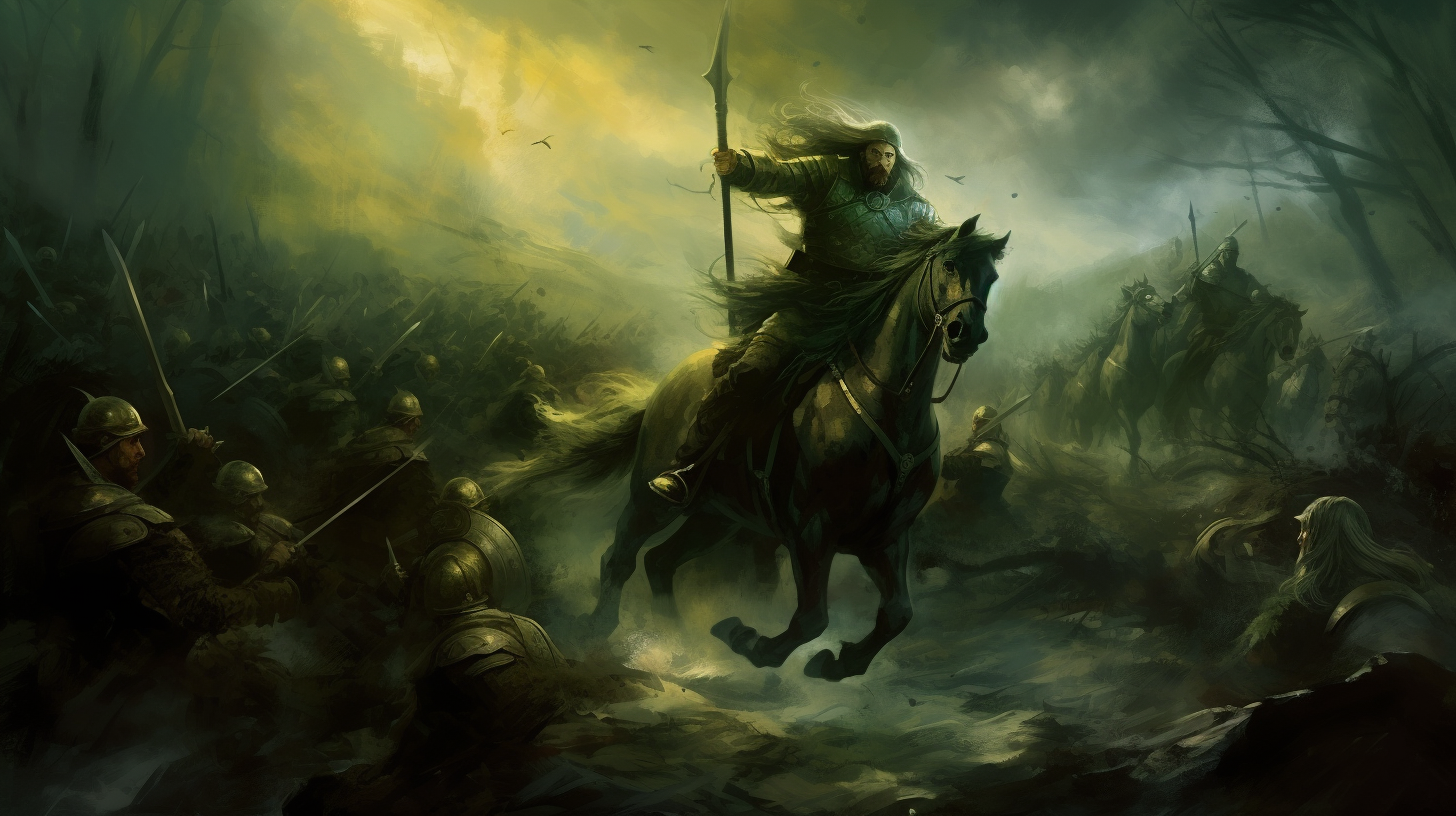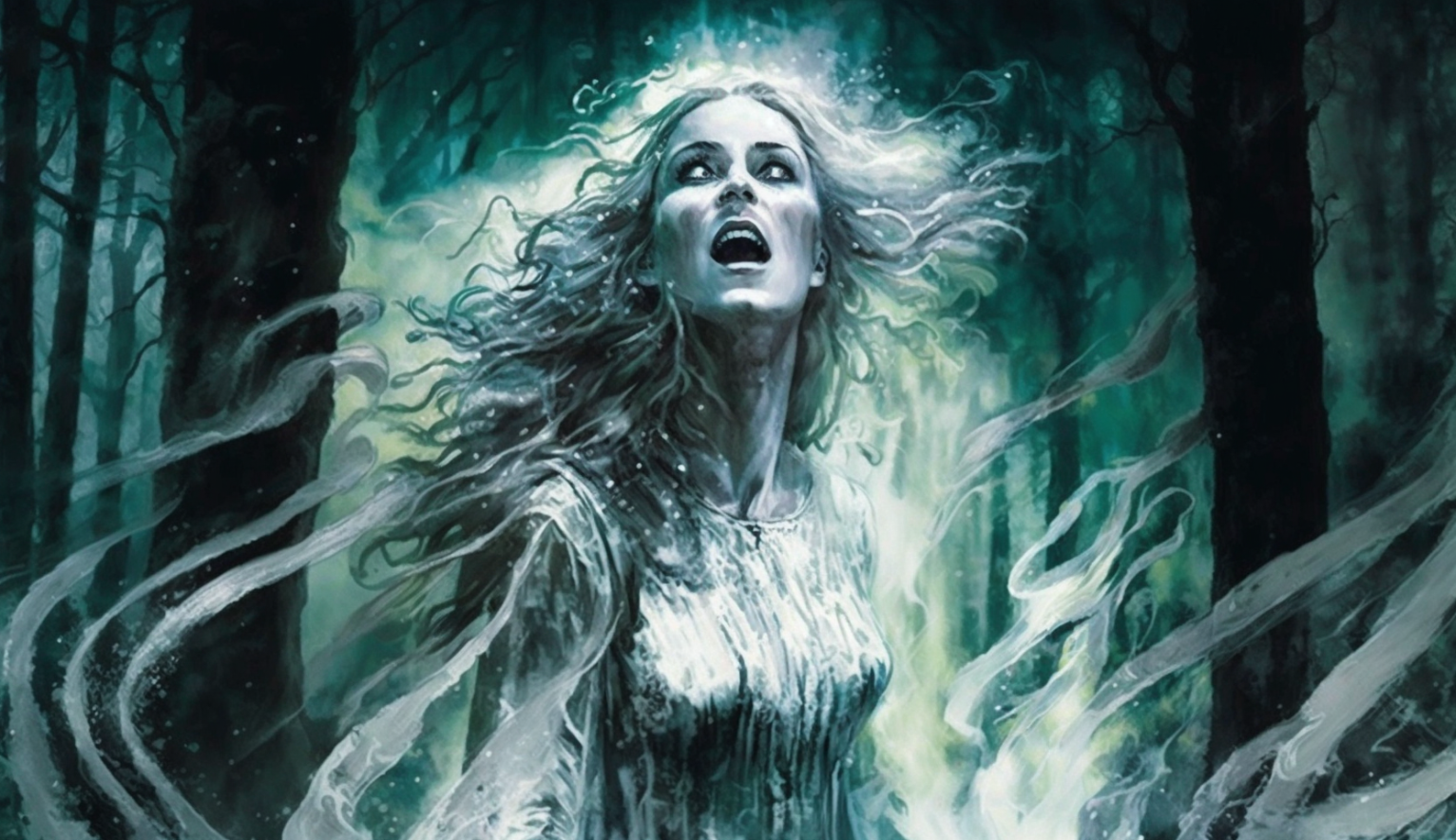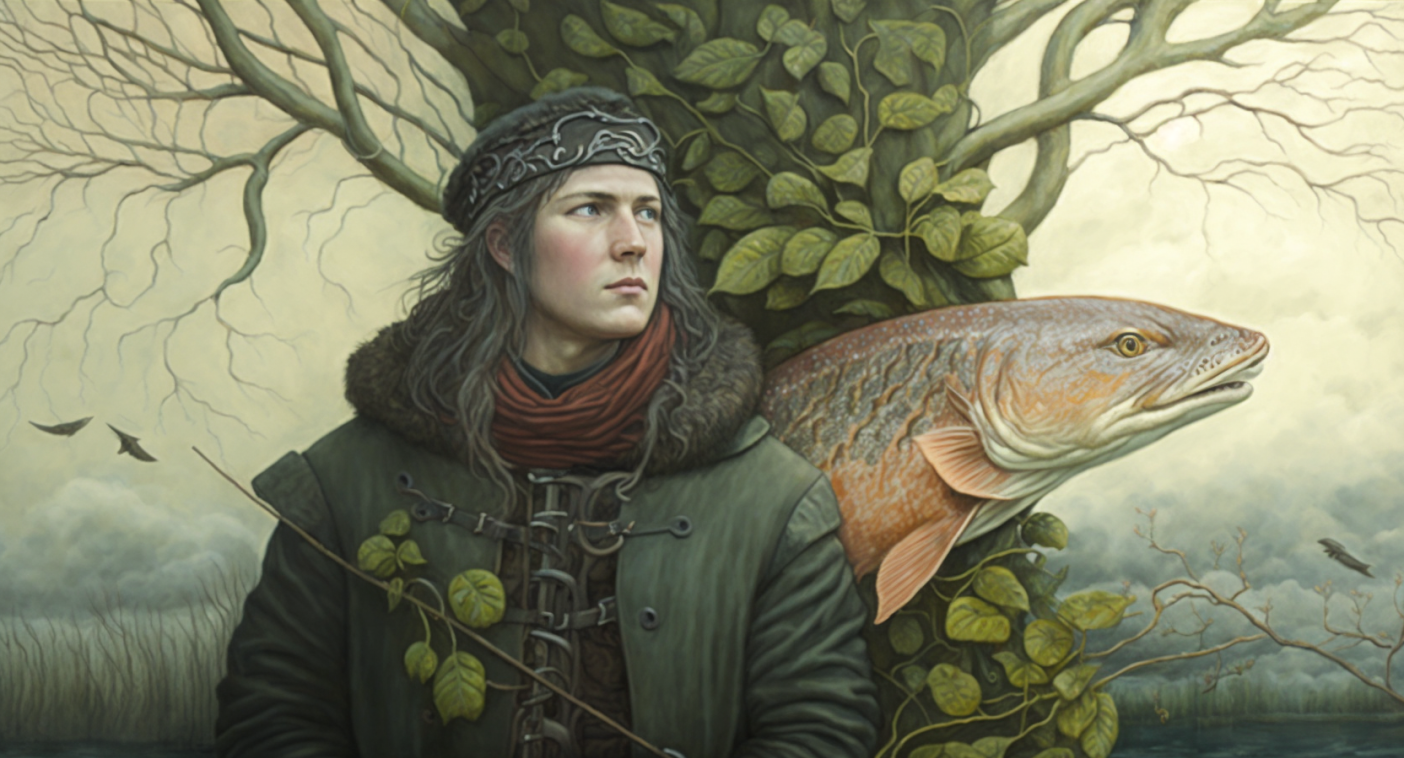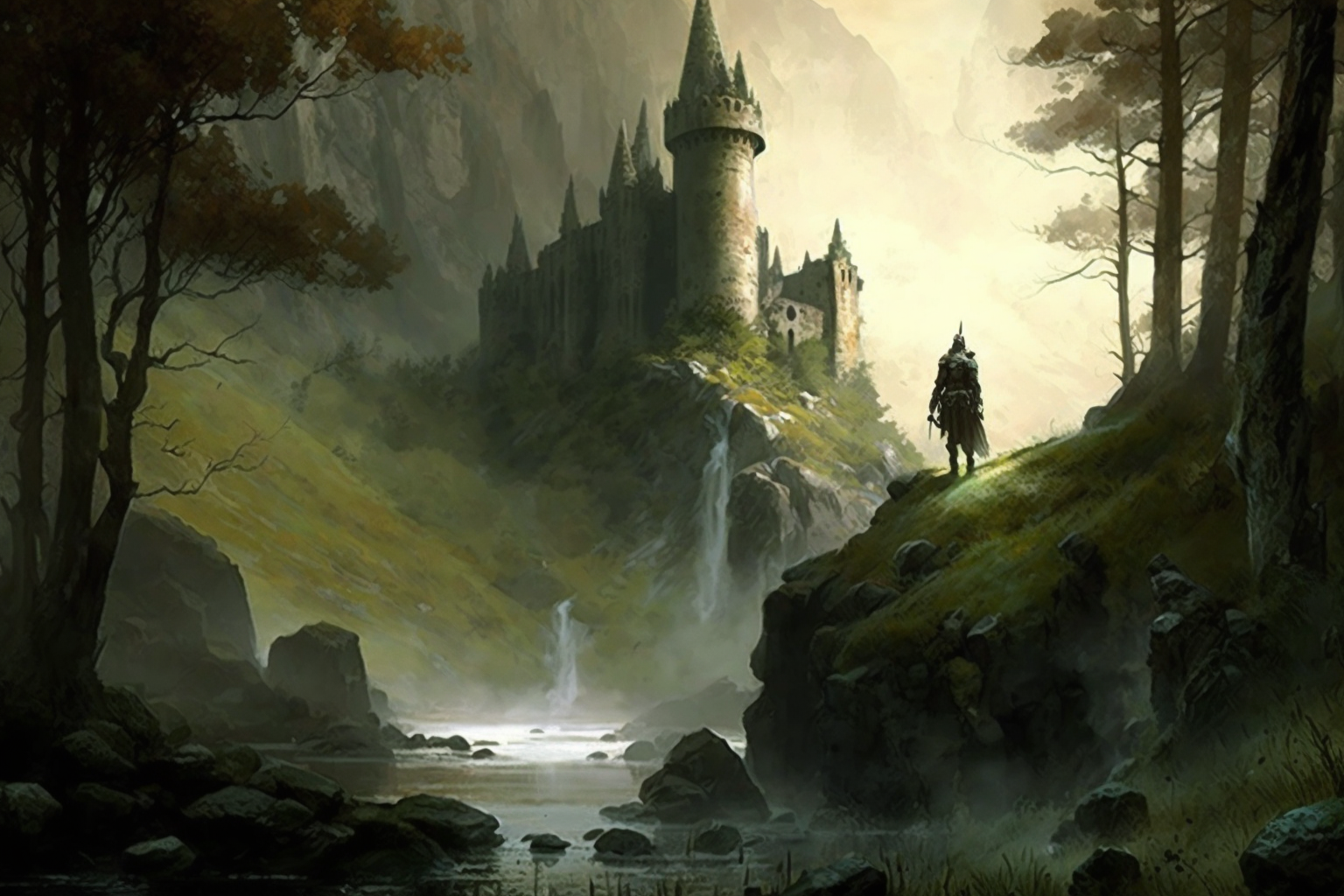AI-generated article summary
Have you ever heard of the mysterious and mischievous shapeshifters from Irish folklore? Meet the Puca (also known as pooka, puka, or phouka), creatures from Celtic mythology. Famous for their dual nature, Pucas can either play tricks leading to chaos and confusion or offer guidance and assistance, making them one of the most enigmatic figures in Irish tales.
In this article, we will explore the different forms of the Puca and the stories that have been told about them.
What does the Puka look like
The term ‘Púca’ translates to ghost or spirit in Irish, though it is typically described more as a creature, notable for its ability to shapeshift. This ability allows the Puca to change its shape and size, adapting to various situations to help or hinder humans.
The Púca takes many terrifying or pleasing forms, including human form, horses, goats, cats, donkeys, bulls, dogs, foxes, wolves, and hares, usually characterized by jet-black fur or with a fine silk suit.
This variety in appearance often leads people to mistake the Puca for a regular animal, unaware of its true nature. Its most renowned form is that of a black horse, which it frequently adopts. Regardless of its form, the Puca cleverly uses its transformative ability to maximize the impact of its interactions with people.
Despite the varying descriptions of its appearance, one feature remains consistent across many tales: its eyes. The Puca is often depicted with large, luminescent golden eyes that stand out regardless of the form it assumes. These glowing eyes can be mesmerizing or intimidating, depending on the story and the Puca’s intentions at the time.
Where do the Pukas live
Old stories tell us that Pucas were once very common and lived in some of the most secluded parts of Ireland, notably in rural and marine communities. These include remote hills, mountains, and bogs, which often feel mysterious and eerie, especially during foggy mornings and gloomy evenings.
It is believed that Pucas might dwell in small, secluded mountain lakes. Some of these lakes are even called ‘Pooka Pools,’ a name that people say means ‘the Demon’s Hole.’ Wrapped in mist and mystery, these areas are classic spots you might think of when imagining where a mythical creature like the Puca would live.
Common Tales and Legends Featuring the Púca
Known for its shape-shifting ability and its role in bringing good and bad fortune, The Púca appears in many traditional stories.
The Púca enjoys confusing people, one of it’s favorite pranks is to transform into a horse and offer wild rides to people who have had too many drinks at the pub.
Despite its love for mischief, the Púca can also be a helpful creature. It has been known to assist farmers by looking after their crops at night, giving gifts, or warning them of upcoming dangers.
To understand more these original creatures here are some of the most famous stories:
The Púca and the King

One of the most famous Púca stories involves Brian Boru, the High King of Ireland. The tale starts with King Brian finding a mysterious horse near the Hill of Tara. Despite warnings from his followers, he bravely rides the horse, which turns out to be a Púca. The creature takes him on a four-day tour across Ireland, sharing secrets about the land and its people.
This adventure doesn’t just show King Brian’s bravery—it also brings him new knowledge and wisdom. When they return, the Púca promises to protect the King and his kingdom, proving that it can be a kind and loyal guardian despite its usual tricks.
The Púca in Lady Wilde’s Poems
Lady Wilde tells a gentler story of the Púca. In her version, a farmer’s son named Padraig meets the Púca, who appears as a young bull and promises to help mill corn at an old mill. The Púca and its friends secretly do all the work at night, which helps Padraig family become prosperous. At Padraig’s wedding, the Púca leaves a golden cup filled with a special drink as a wedding gift, wishing him happiness.
The Púca and the Cobbler

Here’s a simple and heartwarming story about a cobbler who was barely making ends meet. Living in a small village, the cobbler was struggling to keep his business alive and was really worried about how he would continue to support himself. One evening, he went to check the traps he had set outside, hoping to catch some rabbits for food. Instead of a rabbit, he found a Púca caught in one of the traps.
The Púca, which looked like a small, wild animal, begged the cobbler to let it go. It promised to make the cobbler rich if he released it. The cobbler felt sorry for the trapped Púca and decided to free it, hoping that the creature would keep its promise.
The next morning, to his surprise, the cobbler found several gold coins in his shoes. This continued every day, and soon the cobbler was no longer poor. This story shows how the Púca can be a magical and mysterious creature that brings unexpected fortune. It also tells us that being kind, even to someone or something that might seem unimportant, can lead to wonderful things.
The Púca and Halloween: A Connection Rooted in Celtic Tradition
The púca is associated with certain agricultural traditions, but perhaps the most famous is its connection to the ancient Celtic festival of Samhain, now known as Halloween. Samhain marks the end of the harvest season and the beginning of winter, a time when the veil between the human and spirit worlds is believed to be at its thinnest.
In the past, farmers would leave behind undesirable crops, known as “puka,” as offerings to the fairies. Some would even leave a “púca’s share” to appease these beings and avoid their harmful tricks. This tradition of leaving offerings to spirits on Samhain night continues in modern Halloween practices, such as giving candy to trick-or-treaters.
The púca are also associated with the day after Samhain, November 1st. By this time, any remaining crops or wild fruits are believed to be spoiled by the púca’s mischief. Interestingly, despite their reputation for causing harm, November 1st is the one day of the year when the púca are said to be civil.
The connection between the púca and Halloween highlights the deep roots of this holiday in Irish tradition, where the lines between the human and supernatural worlds blur, and offerings are made to appease the spirits that roam the earth.
From Irish Folklore to Popular Culture
The Púca, a creature first mentioned in Irish oral tradition, has significantly influenced modern media and literature. It appears in various forms across mainstream entertainment, showcasing its lasting and adaptable charm.
Literary Influences
Lady Wilde and W.B. Yeats have helped keep the stories of the Púca alive, making them a key part of Irish culture. In her book “Ancient Legends, Mystic Charms, and Superstitions of Ireland“, Lady Wilde focused on the magical and meaningful sides of these tales, showing why they matter. Meanwhile, W.B. Yeats in his book “Fairy and Folk Tales of the Irish Peasantry” used his poetry to highlight the Púca’s mystery and charm, making these stories feel almost magical.
Theatrical Interpretations
Perhaps the most famous academic nod to the Púca is through the character of Puck in William Shakespeare’s “A Midsummer Night’s Dream.” While not a direct adaptation, Puck embodies the mischievous nature and magical abilities characteristic of the Púca. Shakespeare’s use of a trickster figure who can manipulate the human world echoes the Púca’s role in Irish folklore, highlighting its influence on even the most celebrated works of English literature.
Modern Media
In contemporary times, the Púca continues to be a popular figure in children’s literature, such as in Tony DiTerlizzi and Holly Black’s “The Spiderwick Chronicles,” where it plays a role in the narrative, introducing young readers to the mythical creatures.

The Púca also appeared in the movie “Harvey” (1950), where the main character, Elwood P. Dowd, claims to have an invisible friend named Harvey, a púca resembling an anthropomorphic rabbit over six feet tall. This portrayal taps into the whimsical and surreal aspects of the Púca’s myth.

